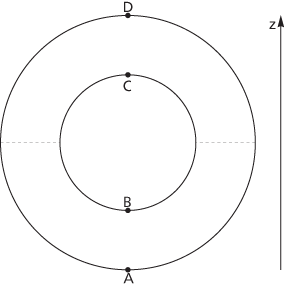Morse Theory
A Morse function on a smooth surface is a smooth real function with only non-degenerate stationary points (see Hessian), and so these are local maxima, local minima, or saddle points. For any smooth function f on a closed, smooth manifold X, it is the case that

where χ(X) denotes the Euler characteristic of X and #maxima denotes the number of maxima, etc. In the figure is a cross-section of a torus and f(x,y,z) = z is a Morse function on the torus. f has a maximum at D, a minimum at A, and saddle points at B and C. This correctly gives χ = 1 − 2 + 1 = 0.

The height function on the torus
Morse theory includes results for the subsets of the surface of the form f ≤ k. In the figure, such a subset is that part of the torus below the dotted lines. For any z-coordinate k between B and C Morse theory states the subsets are homotopy equivalent. Further, the theory states how the homotopy type of the subset f ≤ k changes as k takes a stationary value.
- group table
- Gödel, Kurt
- Gödel numbering
- Gödel's Completeness Theorem
- Gödel's Incompleteness Theorems
- h
- Haar measure
- Hadamard, Jacques
- Hadamard's inequality
- Hairy Ball Theorem
- half‐angle formula
- half‐closed
- half‐life
- half‐line
- half‐open
- half‐plane
- half‐space
- half‐turn symmetry
- Halley, Edmond
- Halley's method
- Hall's Theorem
- Halmos, Paul Richard
- Halting problem
- Hamel basis
- Hamiltonian